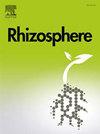被忽视的盐不同硫酸钠含量下暗色隔膜内生菌对紫花苜蓿的影响
IF 3.4
3区 生物学
Q1 PLANT SCIENCES
引用次数: 0
摘要
硫酸钠(Na2SO4)是盐碱地中广泛存在的一种钠盐;在某些地区,硫酸钠是主要的盐分。暗隔内生菌(DSE)能增强植物对压力环境的抵抗力。然而,人们对 DSE 在增强植物对 Na2SO4 的耐受性方面的作用知之甚少。本研究考察了暴露于不同浓度(0%、0.15%、0.3% 和 0.45%(w/w))Na2SO4 的紫花苜蓿植物的 DSE 生长情况及其影响。我们的研究结果表明,即使在盐胁迫环境中,DSE 也能茁壮成长。在培养的第 8 天,它们的生物量在 0.45% 的盐浓度下达到最高水平。此外,DSE 还成功地在紫花苜蓿根部定殖,并在各种盐梯度条件下显著促进植物的生长和发育。值得注意的是,在 0.45% 的盐浓度下,DSE 对紫花苜蓿总生物量的贡献率最高,达到 68%。同时,在不同的盐分梯度下,DSE 能显著减少根部 Na+ 的存在。此外,在盐浓度为 0.3% 和 0.45% 时,DSE 能明显提高过氧化氢酶(CAT)的活性。我们的研究还发现,植物生物量与根指数、根的 K+ 含量和 K+/Na+ 比率呈强正相关,而植物生物量与根的 Na+ 含量、土壤的 Na+ 和 SO42- 含量呈强负相关。结构方程模型(SEM)表明,在各种盐胁迫下,DSE 通过增加根的长度、降低根的 Na+ 含量和提高 CAT 活性间接提高了植物芽的生物量,而盐则通过减少根的长度或增加根的 Na+ 含量间接降低了植物芽的重量,或直接对植物芽的生物量产生负面影响。因此,DSE 有助于提高植物的耐盐性,这对盐碱地的管理具有重要的战略意义。本文章由计算机程序翻译,如有差异,请以英文原文为准。
The overlooked salt: Impact of dark septate endophytes on alfalfa at varying sodium sulfate levels
Sodium sulfate (Na2SO4) is one sodium salt extensively found in saline soils; in certain regions, it is the dominant salt present. Dark septate endophytes (DSE) are competent in enhancing plants’ resistance to stressed environments. Nevertheless, little is known about the role of DSE in enhancing plant tolerance to Na2SO4. This study examined DSE growth and its impacts on alfalfa plants exposed to varying Na2SO4 concentrations (0%, 0.15%, 0.3%, and 0.45% (w/w)). Our findings revealed that DSE can thrive even in salt-stress environments. On the 8th day of cultivation, their biomass reached the highest level under 0.45% salt concentration. Moreover, DSE successfully colonized alfalfa roots and significantly enhanced plant growth and development across the various salt gradients. Notably, DSE made the highest contribution 68% to the total biomass of alfalfa at 0.45% salt concentration. Meanwhile, DSE significantly decreased the presence of root’s Na+ across varying salt gradients. Additionally, DSE significantly increased catalase (CAT) activity at salt concentrations of 0.3% and 0.45%. Our study also revealed strong positive correlations of plant biomass with the root index, root’s K+ content, and K+/Na+ ratio, and strong negative correlations of plant biomass with root’s Na+ content and soil’s Na+ and SO42− contents. Structural equation modeling (SEM) demonstrated that DSE indirectly enhanced plant’s shoot biomass under various salt stresses via increasing root length, decreasing root’s Na+ content, and raising CAT activity, while salt indirectly reduced plant’s shoot weight via reducing root length or increasing root’s Na+ content or exerted a direct negative effect on plant shoot biomass. Thus, DSE are instrumental in bolstering the salt tolerance of plants, which holds strategic importance for the management of saline-alkali soils.
求助全文
通过发布文献求助,成功后即可免费获取论文全文。
去求助
来源期刊

Rhizosphere
Agricultural and Biological Sciences-Agronomy and Crop Science
CiteScore
5.70
自引率
8.10%
发文量
155
审稿时长
29 days
期刊介绍:
Rhizosphere aims to advance the frontier of our understanding of plant-soil interactions. Rhizosphere is a multidisciplinary journal that publishes research on the interactions between plant roots, soil organisms, nutrients, and water. Except carbon fixation by photosynthesis, plants obtain all other elements primarily from soil through roots.
We are beginning to understand how communications at the rhizosphere, with soil organisms and other plant species, affect root exudates and nutrient uptake. This rapidly evolving subject utilizes molecular biology and genomic tools, food web or community structure manipulations, high performance liquid chromatography, isotopic analysis, diverse spectroscopic analytics, tomography and other microscopy, complex statistical and modeling tools.
 求助内容:
求助内容: 应助结果提醒方式:
应助结果提醒方式:


